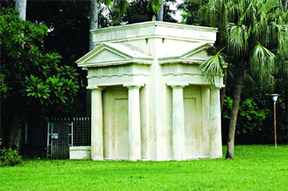
| ⟪ TSC ⟫ | «Newspaper» | «Home» | «Map&Rev» |

Fashioned in a perfect Doric style, a Greek mausoleum stands on the east of the Teachers-Students Centre at Dhaka University as the only testimony to the presence of the Greeks in this region.
The structure was built between 1800 and 1840, and many historians believed in 1815, at the initiative of Reverend JM MacDonald of the St Thomas' Church.
It is square with a flat roof, with projected façades on all sides and an entrance on the east. The building has a Greek inscription — ΜΑΚΑΡΙΟΙ ΟΥΣ ΕΞΕΛΕΞΩ ΚΑΙ ΠΡΟΣΕΛΑΒΟΥ (makarioi ous exelexo kai proselabou, transliterated) — above the entrance, written in capital letters. It means Blessed are those that you have chosen and taken from the burial services of the Book of Pslams.
There are nine tombstones still fixed on the wall, and another lies broken on the floor. The oldest stone is of Sultana Alexander, who died on February 6, 1800. A stone bears the names of the three Ellias brothers. John Demetrius Ellias (d 1836), one of the brothers, was killed by a tiger while he was hunting at Mirpur, 25 miles off what is now the Dhaka University campus.
Basil Demetrius, the Greek clerk at St Thomas' Church, was also buried at the place. Besides being a church clerk, he was also a writing master and a teacher at the Dhaka College for 10 years. He died in 1860.
Muntasir Mamun in his book, Dhaka: Smriti Bismritir Nagari, quoted Ahmed Hasan Dani as writing about two Greek brothers, who traded in jute in Narayangaj.
Among the foreigners the Greeks were the last to settle as a community in Dhaka. And many of them became fairly rich trading in salt and jute. James Taylor, in his book which has been translated in Bangla as Kompani Amale Dhaka, said one Argiri who founded the Greek community in Koltaka died in Dhaka in 1777. And his sons lived in Barisal and Dhaka. And historians believe others might have come here to settle much after the time.
Colonel Davidson, who visited Dhaka at the time, said the Greeks founded a church in Dhaka in 1821 which was completely destroyed by an earthquake in 1897. And there was a Greek cemetery, probably on the west of the Ramna Race Course, where the Atomic Energy Commission building is now situated.
Henry Walters, in his article 'Census of the City of Dhaka' published in 1837 wrote in 1832, there were 21 Greek residences in Dhaka. Taylor also said in 1840 that there were 12 Greek families.
Davidson said there was a graveyard somewhere near the Ramna Race Course. Historians believe there were no Greeks in Dhaka by the end of the nineteenth century.
Akkas, Abu Jar M. (2006 Aug. 1). A piece of Doric Greece on Dhaka University campus. New Age
Rev.: vi·vi·mmxxiii